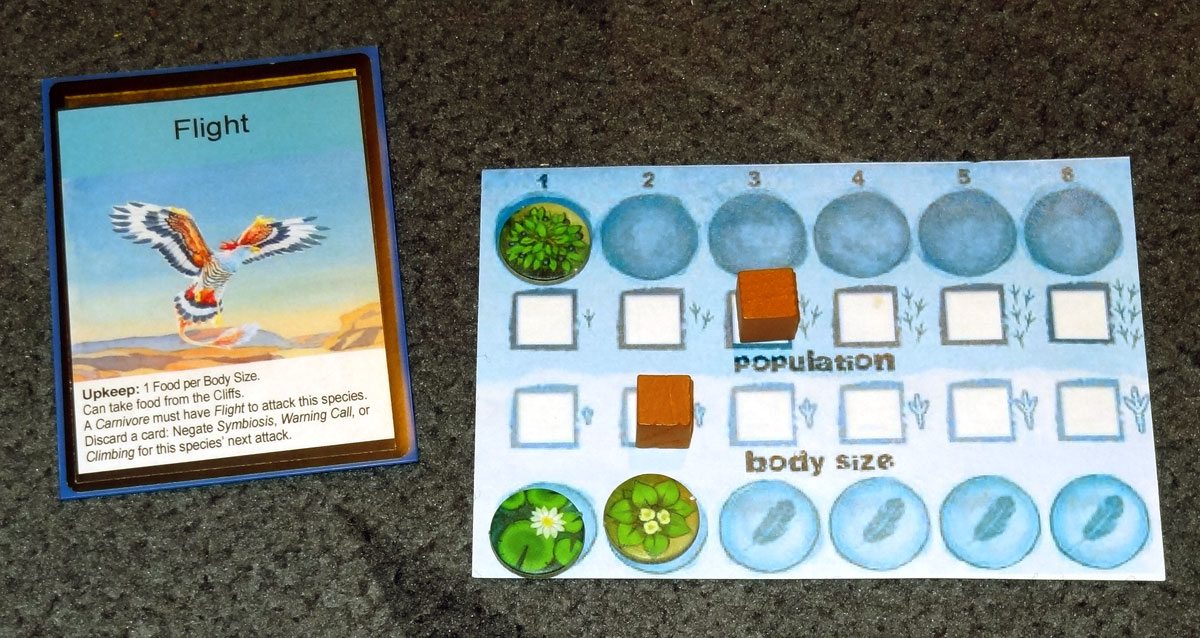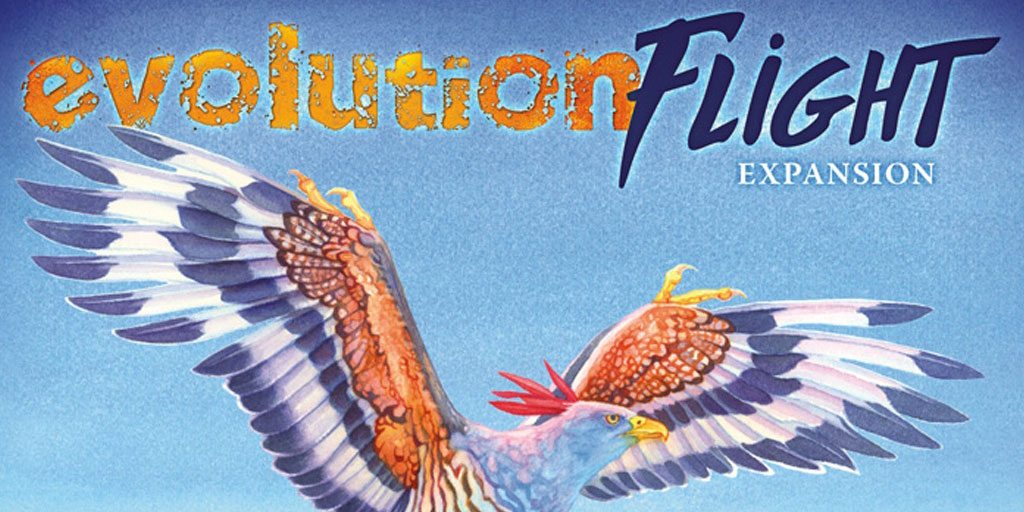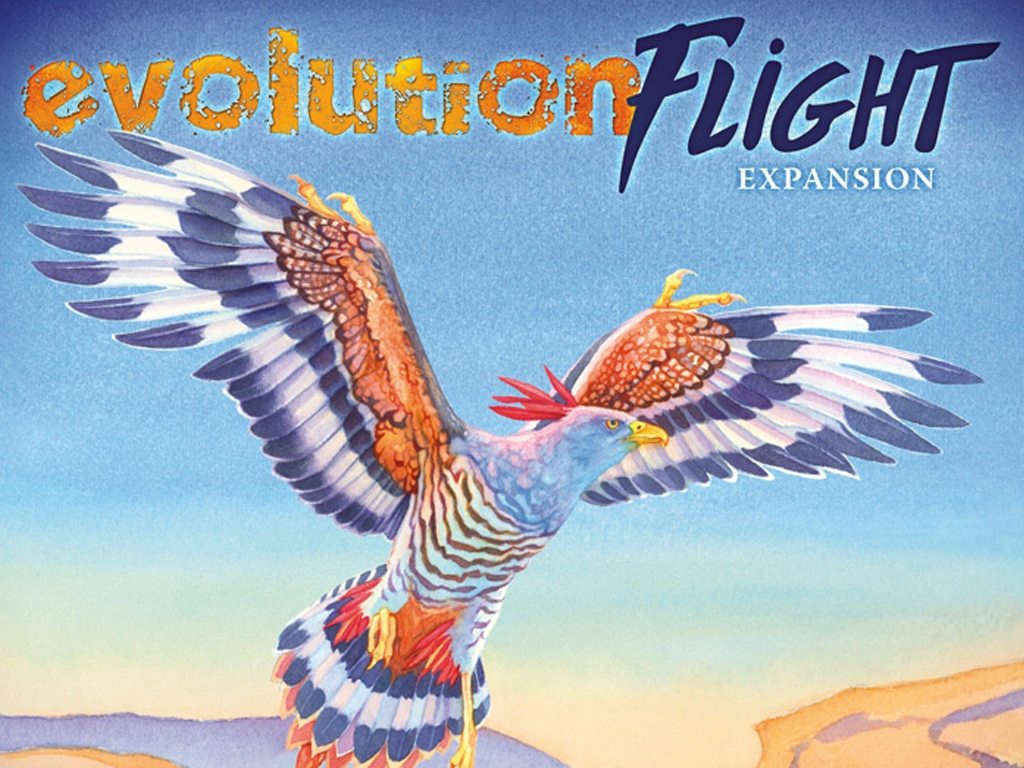It’s getting crowded down here on the ground: not only are there carnivores trying to hunt you down, but there’s so much competition for plant food that it’s getting pretty scarce. Maybe it’s time to take to the skies, with Evolution: Flight.
At a glance: Evolution: Flight is an expansion to Evolution, so you will need the base game to play it. It’s for 2 to 5 players, ages 11 and up, and takes about an hour to play. On the Kickstarter campaign, you can pledge for a copy of just the expansion for $25, just the base game for $55, or both for $80. Note: this is the second edition of the base game, which does have some changes from the original.
New to Kickstarter? Check out our crowdfunding primer.
Components:
- 1 Cliff board
- 12 Flying Species boards
- 12 Flight Trait cards
- 48 Trait cards
The Cliff board is similar to the Watering Hole, and will be placed in the center of the table.

The Flying Species boards are like the original species boards, with spaces to track food, population, and body size, but there’s an additional track marked with feathers–these are to track food that will be burned just to maintain wings.
The Flight trait cards will be cardboard, since they do not get shuffled in as traits.
There are several new trait cards–some of them can only be played on flying species, but others can have benefits even for landbound species. Some of the cards are also Event cards, which work differently.

The artwork for the new cards was also done by Catherine Hamilton, whose wonderful watercolor illustrations straddle the line between realistic and fanciful. Not all of the creatures depicted are ones that exist in nature, but they’re done in a style that makes them look natural (if a little more colorful).
One thing that has been noted during play is that, although the artwork is lovely and I really like it, it can be hard to tell what somebody across the table has played on their species. The cards rely on text (and in some cases colors) but there aren’t large obvious icons that can be read from across the table, unless you’re already familiar with the cards and illustrations that accompany them. That can make it tricky to figure out quickly whether somebody across the table is a threat… or potential food.
How to Play
If you’re not already familiar with Evolution, check out my review of the original game here. I’ll outline what the Flight expansion adds to the game.
The basic gameplay is still the same as the original, including scoring: you get points for food eaten, plus population and traits of any species that survive until the end.
For setup, you’ll shuffle all the trait cards and remove 30 of them, setting them aside. When the main deck runs out, that triggers the end of the game, and these 30 cards are used for the remainder of the game.

Now, in addition to buying a regular species by discarding a card from your hand, you may also purchase a flying species for two cards. You take a flying species board and the Flying trait card. Flying counts as one of the species’ three traits, and like other traits it may be discarded and replaced (in which case you switch to a regular species board). When a flying species takes food, it must first place it on the feather spaces, which are an upkeep cost for having wings. You have to collect food equal to your body size before you can take food to feed your population–this food will be returned to the food bank at the end of the round, so you don’t get any points for it.
If you’re a flying carnivore, you may also discard cards from your hand to negate Symbiosis, Warning Call, and Climbing. So Flying lets you cancel out some defensive traits, but at the cost of extra cards. There are also some trait cards, like Nesting and Brood Parasite, that can only be played on flying species.
When the food cards are revealed and food is added to the Watering Hole, you’ll also add food to the Cliff board–one plant food per player. Flying species can eat from either the Watering Hole or the Cliff, but non-flyers don’t have access to the Cliff.
There are two new Event cards–they’re mixed in with the trait cards, but aren’t placed on a species. Seed Dispersal can be played at any time during your “Play Cards” phase, and it lets you add food to the Watering Hole equal to the total population of your flying species. Dive-Bomb can be played at any time after trait cards are revealed to give one of your flying species an immediate feeding turn.

The Verdict
I really enjoyed Evolution when I first played the prototype for the original Kickstarter campaign, and I was pretty pleased with the way it turned out. There were a few gameplay tweaks between the version I played and the published version, but not too much–mostly it was just going from a prototype without art to the final version. In my original review, I said that Evolution isn’t really an educational game, but I think I have to modify that statement. What I mean is that it’s not a game for which education is its primary purpose–it’s designed to be a fun strategy game. However, the theme is tied closely to the game’s mechanics, and I would posit that playing this game is educational to some extent.
Since then, the first two printings of Evolution have sold really well, and North Star Games is actually getting ready to release the second edition based on feedback from a lot of players. I’ve gotten a peek at an early copy of the second edition, and I think it works well–but I’ll have more about that in a later post. (Note: if you already own the first edition, the first stretch goal is for update cards–that way, you can pledge for the expansion only, and get the 100 cards that changed from first to second edition included!) Since I’m hoping to write up the second edition of Evolution in more detail soon, I’ll focus mostly on the Flight expansion here.
If you have Evolution already and enjoy it, you’ll probably want to get flight. The flying species introduce yet another type of trait that you can play around with, and it can be pretty fascinating. So far I’ve only gotten to play a couple of times, and everyone has had trouble making flying carnivores and keeping them alive–since carnivores generally can only eat things that are smaller than themselves, but flying creatures are limited in size. That, plus the additional food cost to maintain the wings, means that flying carnivores often starve out before they get any traction.
However, flying species can open up other types of strategies, too. For one, they can feed from either food source, and early in the game if there are few flying creatures then you get the whole Cliff to yourself for a while. But you can keep feeding from the Watering Hole first, depleting the food there, letting food accumulate up on the Cliff until you really need it.
A flying creature with the Cooperation trait can also retrieve food from the Cliff for its neighbor, allowing you to feed your land animals with your birds. Too many flying species, though, and all the plant-eaters might starve.
Earthbound carnivores who want to attack flying creatures will have to rely on Intelligence, which lets you discard a card to cancel a trait. That’s when the flyers start evolving other traits–and in this game, you can have a flying creature with a hard shell, or horns.
One thing I’ve discovered is that Evolution is a fairly deep game. There are things that you won’t discover, combinations of traits that work really well, until you’ve played several times. Throwing in flight and a few other traits mixes that up even more and opens up even more possibilities. I like that this expansion doesn’t throw in too many new rules, so it’s not difficult to pick up if you’re already familiar with the base game.
If you haven’t ever played Evolution, it’s one that I definitely recommend trying out–you can pledge for just the base game through the Kickstarter. You might still be able to track down a copy of the first edition, but you can get the second edition through the Kickstarter campaign and if you don’t mind waiting until this summer I’d recommend that one simply because it has been updated and improved.
The Flight expansion is a lot of fun and it’s one I think I’ll usually want to include when I’m playing, though perhaps not for new players. I did introduce the base game with the expansion to a few players for reviewing purposes, but I definitely had an advantage, knowing the old cards already.
For more about Evolution and the Flight expansion, visit the Kickstarter page.
Disclosure: I received an advance copy of Evolution (2nd edition) and the Flight expansion for this review.






Jonathan,
Great review. I will say though that a flying carnivore with Pack Hunting is brutal, especially with the new text in the 2nd Ed. The new text adds your Population to your Body Size when determining who you can attack, so a bird could have an effective Body Size 9, which will allow them to eat almost anything from a size perspective. And since birds also have to eat for their Body Size, a carnivorous bird with Pack Hunting that has a Pop of 6 and a size of 3 would eat 9 food every turn. Yikes!